The over one billion automobiles in existence owe much of their functionality to basic reactions in chemistry. In the U.S. alone there are over 250,000,000 cars in operation, a vast majority of which were built in the last 15 years.
The chemical processes behind moving vehicles are simpler than you think. Here’s a breakdown of what’s going on under the hood.
Fuel Injection
Without an injection of fuel to a vehicle’s engine, it won’t run. There are several different types of fuel injection including direct injection, sequential, single-point, and multi-point, among others. Most engines are fed when pressurized, atomized fuel vapor is distributed to their cylinders. From there, a spark ignites the fuel atoms themselves – typically comprised of petroleum that’s been enhanced with stabilizing additives – causing the gasses to combust. This combustion causes the molecules to expand and, most importantly, to release heat.
Chemical Cooling Systems
Nearly all modern vehicles use a system of liquid cooling to keep temperatures in the engine block stable. As the engine puts off heat, a network of tubes filled with coolant syphon heat from the surrounding air. What kind of coolant works best? Ideal cooling liquids must have a high relative boiling point as well as a low freezing point; today, an ethylene glycol + water solution is the most commonly-used commercial coolant. (Ethylene glycol is colloquially known as “antifreeze”.) Generally, a 1/1 solution of (CH₂OH)₂ and H₂O provides a good balance of cold-tolerance and heat-resistance, but in extremely cold climates a higher concentration of ethylene glycol is advisable.
Electric Battery Packs
Electric vehicles use a completely different chemical process than traditional fuel injection systems. Battery packs for electric cars are becoming increasingly dense with energy, and today’s most cutting-edge versions are made using lithium-ions. There are several different kinds of electric batteries commercially available, though, including lead-acid, nickel metal hydrides, and molten salt. Chemical solutions are underway to make electric battery packs safer and more stable, including the addition of silicon to batteries’ anodes.
Automotive chemistry is undergoing a significant shift as more and more electric vehicles hit the road. Noah Chemicals is a proud supplier of high-purity chemicals used in both the production and research of automotive components.
For more information on how Noah Chemical’s products can complement your project, reach out to one of our full-time chemists today.




